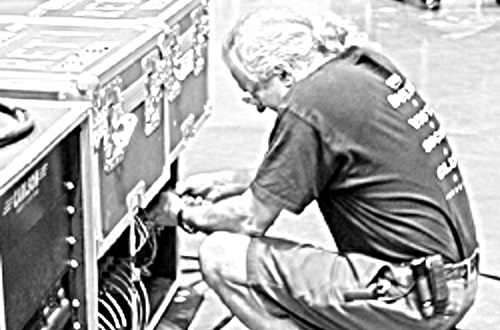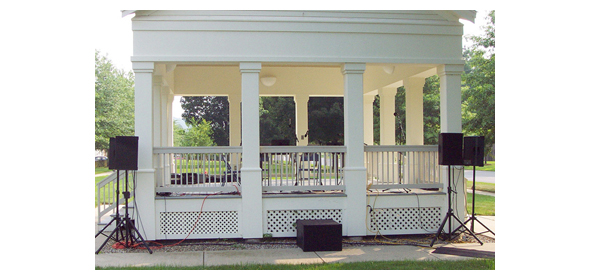
Same Or Different
Next on the list is making sure various parts of a system are working correctly with each other, and things like crossover and amp settings are correct.
If the units are from the same manufacturer and there’s a dedicated system controller with factory settings, there’s not much you should need to do.
On the other hand, if utilizing loudspeakers, DSP or crossovers with external amplification from different manufacturers, now’s the time to double check that every setting is configured correctly, especially gain structure. The key here is avoiding overdriven or clipped signal that distorts.
I start by turning off all gain controls on every piece of gear in the signal chain. Next I use a test signal (i.e., a sine wave) and set the channel trim, channel fader and master fader so the mixer is outputting a maximum signal without clipping. The clip indicators and metering on the mixer serve as a reference.
Then without changing the mixer’s signal output, it’s time to adjust the level controls on each following piece of equipment. The goal is for them to run as high as possible without clipping. One other thing: when mixing, never run a console’s output into clip so there’s some headroom available.
Applying The Basics
Another thing I’ve seen a lot is that the provider doesn’t bring enough rig for the gig, and/or deploy what they have correctly. When I started in pro audio, there was a formula that most sound companies used stating there should be 10 watts for every person in the audience. Now, we all know (right?) that wattage is not a good measurement of volume because various loudspeakers have different sensitivity ratings, with placement and coverage angle also factoring into the equation. But back then it was a good starting point.
The most powerful amps my company carried in that era were Crown DC300s and Peavey CS 800s (rated at 340 watts RMS into 4 ohms and 400 watts RMS into 4 ohms, respectively), but with our horn-loaded cabinets, we could get a respectable 100 dB about 100 feet away (measured with a Radio Shack level meter, of course). Today I know a little more about audio, and specifically a little thing called the Inverse Square Law, which states that when the distance from a sound source is doubled, the sound pressure level (SPL) will be reduced by 6 decibels (in an area without reflective surfaces).
Now some of you may start thinking that you’ve heard that line array cabinets only drop off around 3 dB per doubling of distance – and that even might apply if one were using a column of just small cone drivers. But for hybrid waveguide and cone woofer-type boxes that typically make up most modern line arrays, the 6 dB rule still applies.
Let’s look at an example of a smaller PA for an outdoor festival with a single full-range and sub cabinet per side. With a seated audience that begins about 10 feet from the loudspeakers, you decide that a level of 95 dB is a pretty good volume for those closest to the stage. At 50 feet, the SPL drops to 81 dB and at 100 feet, the crowd is only getting about 75 dB, barely above the background noise.
So if the audience spans deeper than 100 feet, the folks in the back will have a hard time hearing. How do we solve this problem? One solution is deploying additional loudspeakers (delays) further out in the coverage area. The delays are positioned forward of the mains, electronically delayed so that their output arrives at the audience at the same time as the output of the mains.
For reference in this regard, the speed of sound is approximately 775 miles per hour (1136.6 feet per second) at sea level in dry air at 75 degrees (Fahrenheit). Most delay units provide adjustments in feet and milliseconds, but if only millisecond are available, a good rule of thumb is to add one millisecond of delay for every foot the loudspeakers are forward of the main PA.
Up In The Air
Poor audience coverage is another ongoing problem. There’s a park in Las Vegas where a contractor installed loudspeakers on lighting poles for background music and announcements. They’re about 14 feet above the ground and are aimed 90 degrees to the side. The announcements are unintelligible and very low in volume. Simply pointing the cabinets down toward the audience would vastly improve the situation.
Same with many portable PA systems – pointing a single 90-degree horizontal dispersion cabinet straight ahead (per side) is not going to provide quality coverage to audience members located off to the sides. Additional cabinets should be deployed to cover that portion of the crowd.
Another way to address coverage is height. Get the cabinets higher up in the air and point them down at the audience. This can be as simple as using a “tilter” device on the loudspeaker stand or mounting it in a bracket that allows adjustment toward the audience.
When using standard trapezoid-type top cabinets on larger outdoor shows, I sometimes place them on a section of scaffolding (that is staked and braced) above the heads of the crowd. Add some AADs (acoustic aiming devices, a.k.a., black-painted pieces of wood) to tilt the cabinets downward, and voila – solid coverage. (Be sure that after getting the angles set to strap the cabinets securely to the scaffolding so they don’t fall.)

